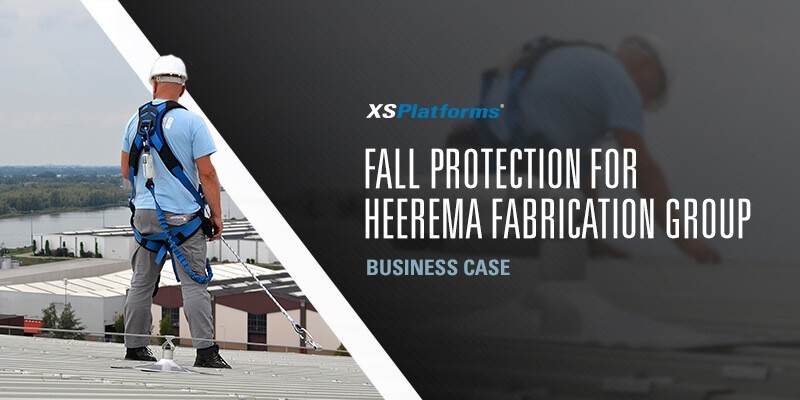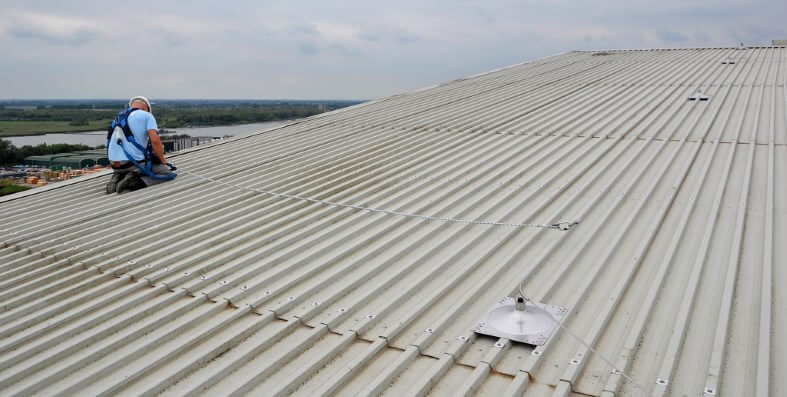
In a new series of articles we would like to tell you more about a selection of our reference projects with extra background information. We want to shed more light on the situation that arose to indicate the need for fall protection. Plus we will, of course, discuss the chosen solution.
For this first article we will look at the circumstances at the offshore construction site of Heerema Fabrication Group in Zwijndrecht (the Netherlands) that led to the installation of various fall protection solutions. These systems were installed in multiple phases over the course of a few years by our longtime Dutch Partner, SkySafe valbeveiliging. The fall protection measures inside the location where installed first, while the installation on the roof came at a later stage.
Project name: HFG Zwijndrecht
Location: Zwijndrecht
Country: The Netherlands
Client: Heerema Fabrication Group
Year: 2014/2018

Heerema Fabrication Group (HFG) designs and constructs structures for the offshore oil and gas industry and energy related industries. Their fabrication yard in Zwijndrecht spans over 146.000 m2 (1.571.531 ft2) and holds two large assembly halls of approx. 45 meters (148 feet) and 36 meters (118 feet) high. It is for these two halls that our Partner SkySafe was asked to provide various types of fall protection solutions, both inside and outside of their facility.
The work locations of HFG can expose workers to an array of fall hazards, both inside the facility as well as on the roof. As HFG dedicates itself to ensuring the safety of all those working at their facilities the fall hazards in- and outside the assembly halls had to be combatted with proper solutions that are both safe and comfortable for the user.
Dutch safety regulations
The regulations in The Netherlands state that employers (or building owners) and employees are both responsible for safety on the job. Employers have a duty to provide those who work at height with measures to safely execute their tasks. The Working Conditions Decree (Arbobesluit 3.16) states that fall protection has to be provided at heights of 2,5 meters (8 feet) or more, to ensure safe work within 0 to 4 meters (0 to 13 feet) of the roof edge or near unsafe zones, such as skylights.
Inside the facility
Within the operations of HFG a lot of heavy equipment is being used daily, for example the large overhead cranes inside both assembly halls. Crane installations of this type require frequent maintenance to ensure its longevity. In order to get access to these cranes, which are located near the roof of the building, workers have to walk along a ledge located at 35 meters (115 feet) above the ground floor with no guardrail or other barriers to protect them. Therefore maintenance personnel have to be protected against fall hazards while they execute their tasks at this height.
Rooftop safety
The need for a fall protection system on the roof arose as the metal roof structure of the assembly halls was in dire need of maintenance after a heavy storm. However, because there was no fall protection present at the time there was no way for maintenance and repair workers to access the low-pitched roof safely.
Another important factor was the strength of the metal roof sheets themselves. In order to create safe passage for workers on the roof, a 215 meter (705 feet) predetermined walk path (walkway) was a desirable option as a safety-precaution and for added comfort.
Solutions
After consultation with a fall protection expert from SkySafe a solution which involves several horizontal lifeline systems for roof and wall mounting where designed for inside the assembly hall and on top of the roof structure.
Factory hall (2014)
To ensure safe access to the ledges that lead to the cranes, high inside the assembly hall, a total of 3 wall mounted lifeline systems, with a combined length of 410 meters (1345 feet) in total, were installed. All systems are mounted directly onto the steel structure of the building that runs along the ledge. With these systems personnel can execute various jobs along the walking surfaces as well as gain access to the factories overhead cranes for repairs and maintenance. This machinery is used daily and needs regular upkeep to ensure minimal down-time. To safeguard the performers of maintenance work horizontal lifelines were installed on top of each crane girder
Roof access (2018)
In order to create safe access for workers to both assembly halls, SkySafe installed several horizontal lifeline systems to both trapezoidal cold roof structures. The roof of assembly hall 1 was outfitted with a total of 5 lifeline systems, spanning a distance of approx. 497 meters (1630 feet) of steel wire-rope installed on XSMD baseplates. These baseplates are specifically designed for installation on these types of cold roofs. Additionally 4 XSGlobe anti-pendulum anchor points were installed at the corners of the roof surface to combat the effects of a possible swing fall. To comfort workers walking the surface, this hall is also outfitted with a custom walkway. This way users can gain better access to the smoke hatches for maintenance and inspection.
Assembly hall 2 has sturdier roof plates and is significantly shorter than assembly hall 1 so a walkway was not laid out for this roof. To provide protection against falls, a total of 4 horizontal lifeline systems were installed. Again on XSMD baseplates. The total length of these systems covers approx. 340 meters (1115 feet). Just as with hall 1, the risk of a swing fall is also present on this structure, so 4 XSGlobe anti-pendulum anchor points were installed on the roof corners.
Custom solution
Do you have a fall protection challenge that you want to discuss with an expert? Feel free to contact us. We believe there is no such thing as a problem. If a challenge cannot be overcome by the products in our range, we can design a custom solution. Want to know more about our products? Download our Fall Protection Brochure, there you’ll find all the information about our systems. You can also contact us directly.


